Test – XFX R9 380 Double Dissipation 4GB: Specs | Price | CPU | Profitability | Hashrate | best Coins | Config | Advantage (Pros) and Disadvantages (Cons) and other important features that will help you make better decision
AMD recently offered us its new graphics cards, in addition to the Fury series which is a new architecture associated with HBM memory which I will not give you a speech because you have probably read it 50 times now there are also the ” news ”3xx. As you have certainly already read also this series is often criticized because once again there has been a major renaming of the old cards, here is a summary table of the 3xx series:
Hashrate – XFX Radeon R9 380 Double Dissipation 4Go
| Menu | GPU | Transistors (in billions) | ROPs | Calculation units | GPU Frequency / Memory | Memory Capacity | Bus |
|---|---|---|---|---|---|---|---|
| R9 295X | 2x Hawaii | 2 x 6.2 | 2 x 64 | 2 x 2816 | 1018/1250 | 2 x 4 GB | 512 bits |
| R9 390X | Grenada | 6.2 | 64 | 2816 | 1050/1500 | 8 GB | 512 bits |
| R9 290X | Hawaii | 6.2 | 64 | 2816 | 1000/1250 | 4 GB | 512 bits |
| R9 390 | Grenada | 6.2 | 64 | 2560 | 100/1250 | 8 GB | 512 bits |
| R9 290 | Hawaii | 6.2 | 64 | 2560 | 947/1250 | 4 GB | 512 bits |
| R9 280X | Tahiti | 4.3 | 32 | 2048 | 1000/1500 | 3 GB | 384 bits |
| R9 380 | Antigua | 5 | 32 | 1792 | 970/1375 | 2 or 4 GB | 256 bits |
| R9 285 | Tonga | 5 | 32 | 1792 | 918/1375 | 2 GB | 256 bits |
| R9 280 | Tahiti | 4.3 | 32 | 1792 | 933/1500 | 3 GB | 384 bits |
| R9 270X | Pitcairn | 2.8 | 32 | 1024 | 1050/1400 | 2 or 4GB | 256 bits |
| R7 370 | Trinidad | 2.8 | 32 | 1024 | 975/1400 | 2 or 4 GB | 256 bits |
| R9 270 | Pitcairn | 2.8 | 32 | 1024 | 925/1400 | 2 GB | 256 bits |
| R7 265 | Pitcairn | 2.8 | 32 | 1024 | 925/1625 | 1 or 2 GB | 128 bits |
| R7 360 | Tobago | 2 | 16 | 768 | 1050/1625 | 2 | 128 bits |
As we can see and despite a renaming of the GPU the characteristics are really very close, for example the only differences between the R9 390X and the R9 290X are an increase of 50 Mhz for the GPU, 250 Mhz for the memory and the passage of 4 to 8 GB of memory, nothing that can logically explode the performance, except in a very high resolution like in 4K with a lot of graphics options activated. The other cards in the series are also a half-disguised rename, with the R9 390 replacing the R9 290, the R9 380 replacing the R9 285, the R7 370 replacing the R9 270 and the R7 260 (which was already a rename of the HD 7850) arriving at the bottom of the table. In short, you will understand the performance should not be a good step forward but rather a very small update,
Characteristics
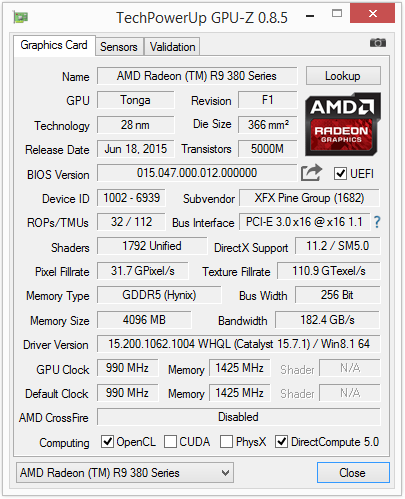
Hashrate – XFX Radeon R9 380 Double Dissipation 4Go
| XFX Radeon R9 380 Double Dissipation 4Go | |
|---|---|
| GPU | Antiqua |
| GPU frequency with boost | 990 MHz |
| Memory Frequency | 1425 MHz |
| Amount of memory | 4 GB of DDR5 |
| Memory bus | 256 bit |
| Connectivity | 2 x DL-DVI-I 1 x HDMI 1.4a 1 x mini Display Port |
| Dimensions | 23.4 x 11.5 x 3.81 cm |
| Food | 2 x 6-pin |
| Guarantee | 2 years |
The XFX R9 380 Double Dissipation 4Go is a rather compact card with its 23.4 cm long, 11.5 cm high and 3.81 cm wide, it can therefore adapt without too much problem to almost all boxes on the market, this change monsters over 30cm in length!
On the GPU side there is an “Antiqua” (which is none other than a renowned “Tonga” and perhaps very slightly modified) clocked at 990 MHz supported by memory operating at 1425 MHz, for your information there is some of that a year almost to the day I tested the R9 285 from XFX still (you can find the test here) running at 975 MHz for the GPU and 1450 MHz for the memory, so the cards should be almost identical in performance (but not that, as we will see a little later).
Regarding the price, it is possible to find this XFX around 225 €, which makes it one of the cheapest models on the market today, and should logically display a good performance / price ratio, if all is right. goes well during the tests!
Box and bundle
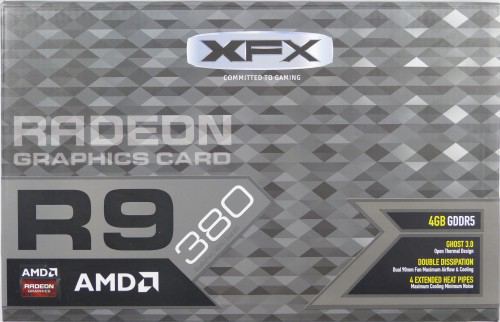
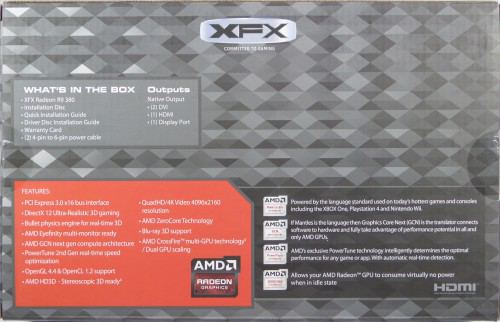
XFX has changed the colors of its boxes, we go from a blue / white for the 2xx series to a mixture of gray for the new cards, at least we will not be able to say that the new ones sting the eyes 😉 On the front face we find the model as well as the amount of memory. At the back a listing of the contents of the box as well as the strengths of the card.

On the edge we find the recommendations for the proper functioning of the card, XFX recommends a power supply of 500 Watts for one card, 600 Watts for 2 cards, at least they do not require a power supply of 1000 Watts 😀
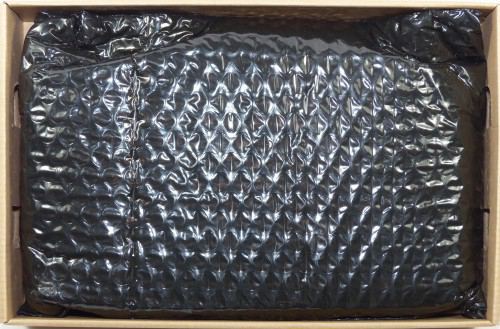
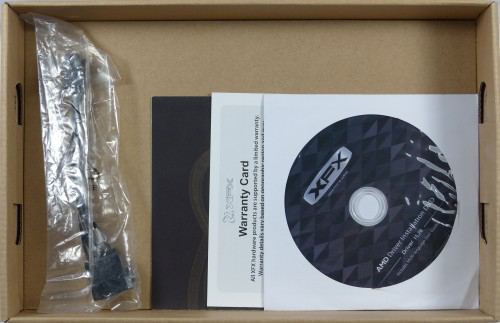
Inside the box we fall directly on a black bubble wrap in which is the graphics card. Under the graphics card are the accessories, as we can see the packaging is reduced to a minimum here!
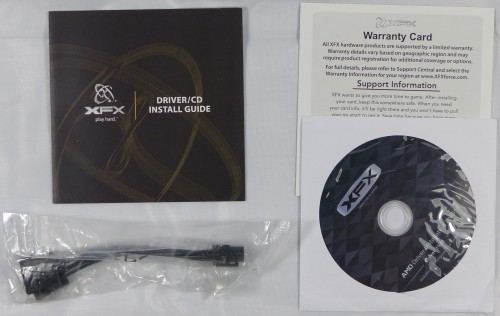
The bundle consists of:
- 1 driver CD
- 1 warranty card
- 1 installation guide
- 1 adapter 2 x 4-pin (molex) -> 1 x 6-pin
We are dealing with a very classic bundle in terms of graphics cards, in addition to the eternal CD of drivers and the quick installation guide, the adapter could prove useful if ever we run out of connectors (this which is not really a good sign if the power supply does not even have 2 PCIe slots!).
The map

Here is the beast! The card is well made, rather light and compact. The brand’s Double Dissipation heatsink changes somewhat here, particularly in terms of the fairing, we leave the plastic fairing of a mold for something a little more sophisticated, it consists of 2 parts each accommodating a fan. The changes don’t stop there as each fan has 2 clips to remove them for easier cleaning, which between us is really a good idea when we know how much dust can accumulate between the fins of the cooler. !
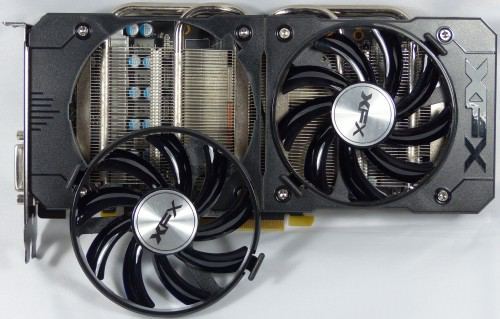
All you have to do is pinch the fan at the 2 clips to take it out of its housing, once cleaning is done it will be very easy!
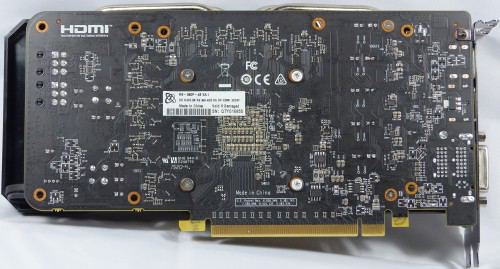
At the back we find ourselves facing a black PCB which presents very well, on the other hand a feeling of familiarity comes to seize me at the time of the discovery of the card, after a quick comparison it turns out that this R9 380 looks like two drops of water like the R9 285 I tested before, you can see the PCB of the latter here.


The similarities with the R9 285 do not end there because the radiator is identical on the R9 380, the only difference being that the heat pipes are nickel plated and therefore look more upscale, which is not a bad thing! We also notice that the memory does not have a radiator.

A great classic in terms of connectivity, 2 DVI ports, 1 HDMI port and a DisplayPort port.
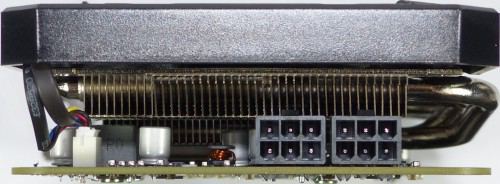
The R9 380 from XFX requires 2 PCIe 6-pin connectors to function, again a classic for a card like this.
We undress the map

Here is the beast in its simplest form! The XFX R9 285 R9 380 does not have radiators other than the VRM one, which should be sufficient but could also be the cause of high noise pollution. On the other hand as much to say it bluntly, the PCB is in all points identical to the R9 285, you can make the comparison with its PCB here, you will find there only very little difference (except the memory).
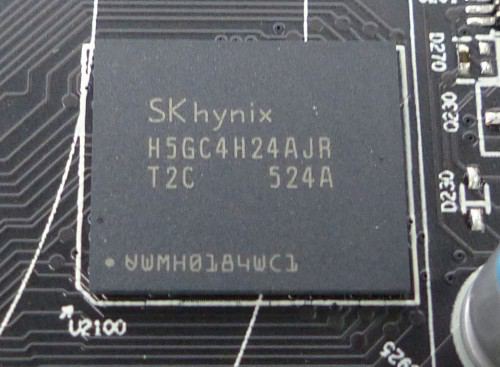
The memory is entrusted to Hynix with given modules to run at a speed of 1500 MHz, so this frequency should be easily usable but the overclocking margin could be limited.
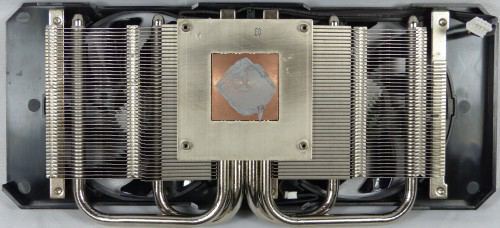
The cooling system is composed of a copper base and held by 4 screws, the great classic here.
The test platform
The configuration used during the tests is as follows:
- Processor : Intel Core i5 4670K @ 4 Ghz
- Motherboard : Gigabyte Z87-UD5H TH
- Memory : Kingston HyperX 4 x 2 GB 1600Mhz
- Hard Drive: WD Raptor 150 GB
- Power supply : Seasonic X650
- Drivers : Catalyst 15.7.1
- Operating system : Windows 8.1 64bits
All games will be tested in 1920 × 1080 detail in full detail (except the TressFX on Tomb Raider), which is the current ‘standard’, the graphics cards used in testing are as follows:
- Asus GTX770 DirectCU OC
- HIS R9 290 iPower IceQ X² OC 4GB (tested here)
- MSI R9 280X Gaming (tested here)
- MSI R9 290 Gaming OC 4GB (tested here)
- Powercolor R9 280X (tested here)
- Sapphire 7950 Dualx @ 900Mhz
- Sapphire 7970 Ghz Edition
- Sapphire R9 280X VaporX Tri-X (tested here)
- XFX R9 280 Double Dissipation (tested here)
- XFX R9 285 Black Edition (tested here)
- XFX R9 290 Double Dissipation (tested here)
- XFX R9 390 Double Dissipation Core edition (tested here)
Consumption / Temperature
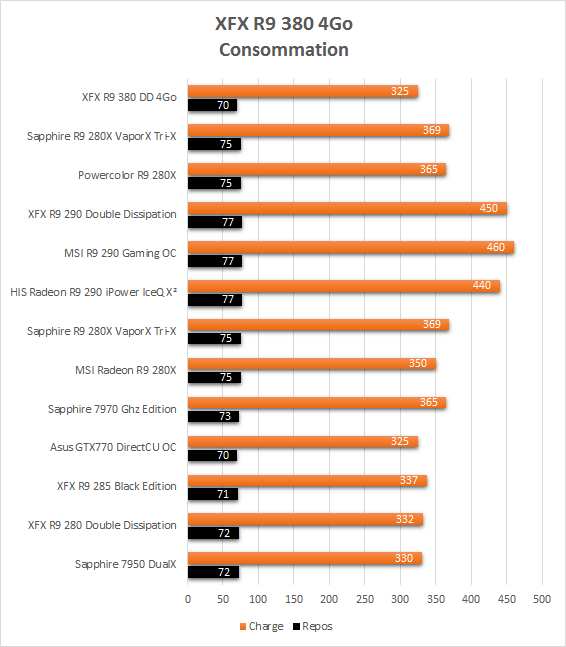
The consumption test was carried out under OCCT Power Supply which makes it possible to push the consumption of the components to the maximum, note that this value reflects the total consumption at the outlet of the machine and not the graphics card itself!
With 325 Watts in load, the configuration equipped with the R9 380 4Go from XFX does better by a few watts than its sister the R9 285 (in 2Go version), we can say that we are staying in the nails here, nothing revolutionary here being given that the card is almost identical!

The original cooling cools the GPU of the R9 380 from XFX very well, with 67 ° under full load it is clear that the card will not overheat, we gain 4 ° at rest and under load compared to the R9 285. On the other hand, since the cooling system is identical, the R9 380 will certainly be noisier, let’s see that right away!
Sound level
Warning: Part to be taken with a grain of salt, unfortunately not having access to the appropriate equipment and using an android application to take the readings The measurements below are only indicative! The readings were taken 20cm from the graphics card.

Unfortunately this is true, the R9 285 was already a noisy card but we still go up in decibels to go up to a maximum of 51 dB (for 2700 RPM) during the OCCT test, it goes without saying that you will hear it and that ‘ is a shame because given the temperatures reached there could have been a better ventilation curve. At rest and with 35 dB the card is discreet but audible with fans running at around 1380 RPM, given that it is possible to manually lower it to around 980 RPM again it is a pity that XFX does not have not benefited.
Powertune
To start, let’s take a look at the Powertune that powers the XFX R9 380 4GB. Powertune is responsible for maintaining the temperature of the processor, the consumption of the card below certain values. During overclocking it is mandatory to be able to modify all the possible settings in order to get the best performance, for Powertune and the R9 380 series (like the R9 280/285) it is possible to increase the consumption limit by 20% card (50% for R9 290 / 290X / 390 / 390X).
Let’s see how the GPU reacts when subjected to OCCT:
Factory settings :

When we do not touch the consumption limit, Powertune brings the cards down to around 885 MHz, which is quite far from the supposed 990 MHz but it is still within the reasonable domain. Let’s see what Powertune has to say when launching 3DMark Fire Strike, which is less greedy than OCCT’s extreme test:
3DMark Fire Strike, factory settings :

The curve is quite different compared to what we observed during the OCCT test, in fact the card remains very close to 990 MHz, without really being 100% of the time at this frequency, perhaps only the modification of the limit. consumption will have an impact?
Consumption limit + 20%, OCCT :

Powertune therefore only asked for a little more juice not to lower the frequencies of the card, the card remains around the original frequency, namely 990 MHz.
What about when the card is subjected to something more representative of what might be asked for in a game, such as during a small 3DMark Fire Stike?
Consumption limit + 20%, 3DMark Fire Strike :

We can say that this is stable, the card remains at 990MHz throughout the test, without batting an eyelid.
3DMark Fire Strike
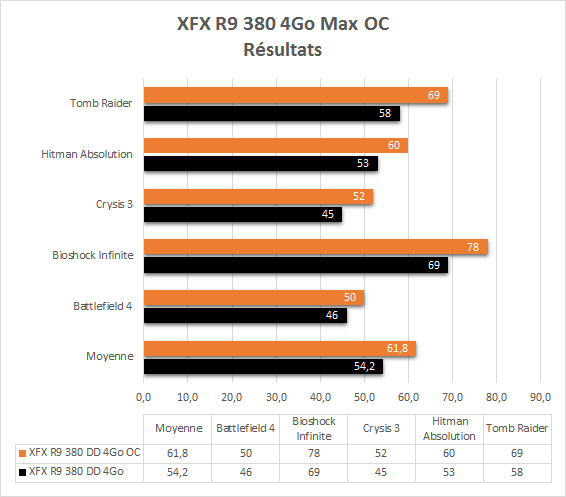
Battlefield 4
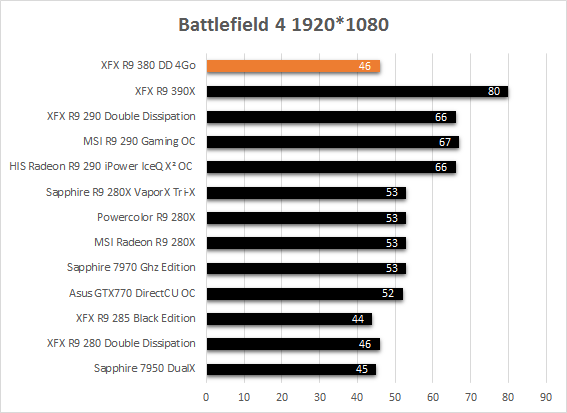
Bioshock Infinite
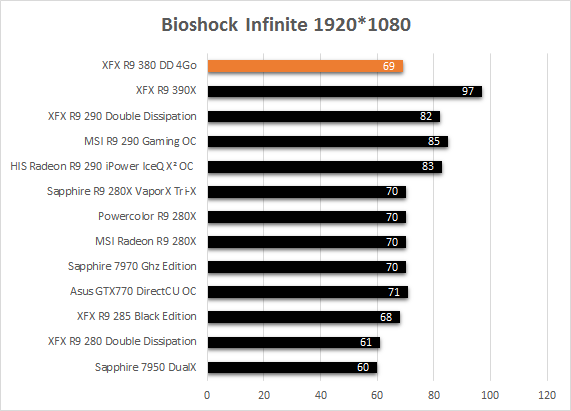
Crysis 3
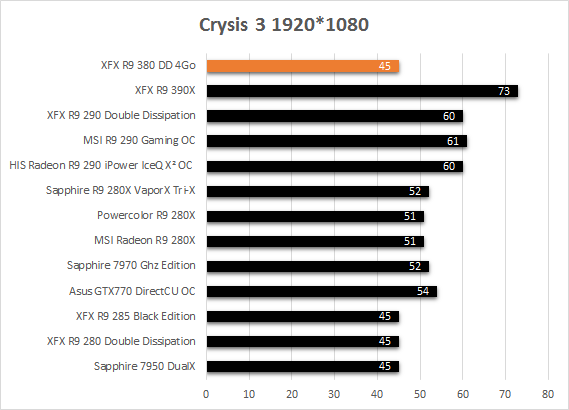
Hitman Absolution
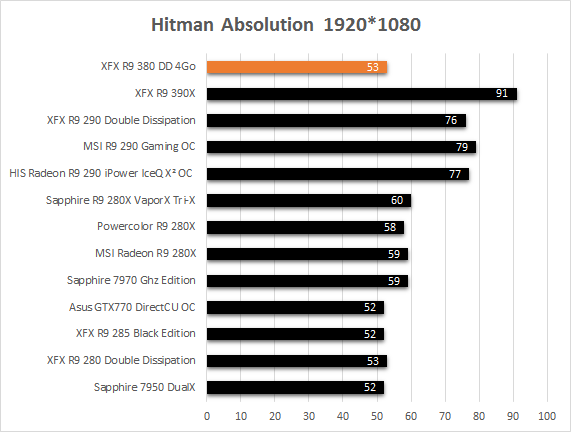
tomb Raider
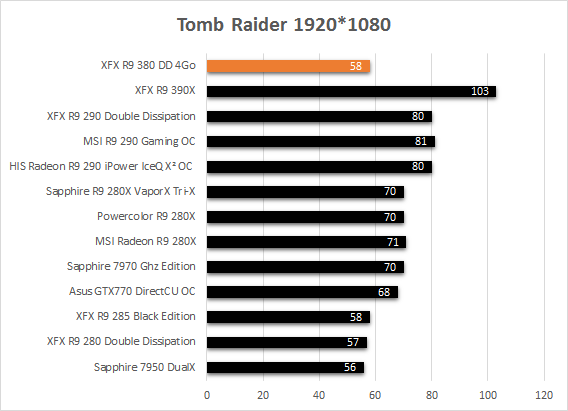
Summary of performance

The performance is compared to a Sapphire HD7950 DualX, which has a base 100 :
The performance is now well known for this type of card, it is nonetheless very good for playing in full HD as you could see in the tests, as long as the most demanding graphics options are removed the R9 380 will be a perfect card for this resolution! Compared to the R9 280/285 it is very slightly faster (thanks to the slightly higher frequencies), but nothing that does not change the situation radically!
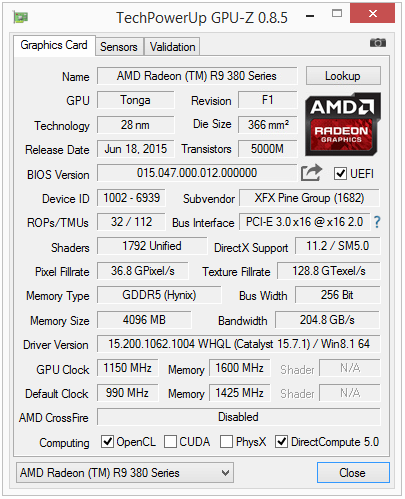
With the help of the 20% additional consumption and a little boost in voltage, this is what the R9 380 from XFX is capable of:
- GPU : 1150 Mhz (+ 160 Mhz)
- Memory : 1600 Mhz (+ 175 Mhz)
- Voltage : +25 mV
The overclocking is more substantial than what I had managed to do on the R9 285 (1050 MHz for the GPU and 1575 MHz for the memory) with 1150 MHz for the GPU (+ 160 MHz or + 16%) and 1575 MHz for the memory (+ 175 MHz or + 10%) by increasing the voltage very slightly by 25 mV, the results should therefore logically be rather pleasant to use!
Consumption
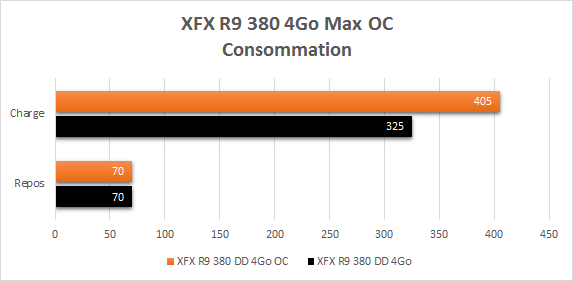
The increase in voltage always goes hand in hand with a drastic increase in consumption, this is indeed the case here with the configuration which goes from 325 Watts to 406 Watts, i.e. an increase of 80 Watts, this is clearly not the case. nothing but nothing that cannot be collected by the docks all the power supplies on the market (I am of course not talking about “no name” power supplies).
Once again the readings were taken at the outlet, and for the complete configuration !
Temperatures
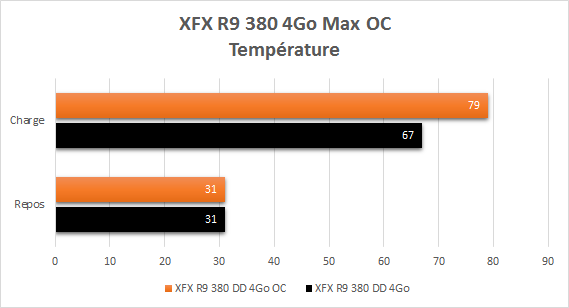
Logically, the increase in frequencies, voltage and therefore consumption means that there is much more heat to dissipate, the GPU then goes from 67 ° in load to 79 °, which in itself is not in effect. nothing a problem because graphics cards can handle this without the slightest problem (and over time). On the other hand, since the card was already noisy before overclocking, it will certainly be necessary to expect worse, let’s see that right away!
Sound level
Warning: Part to be taken with a grain of salt, unfortunately not having access to the appropriate equipment and using an android application to take the readings The measurements below are only indicative! The readings were taken 20cm from the graphics card.
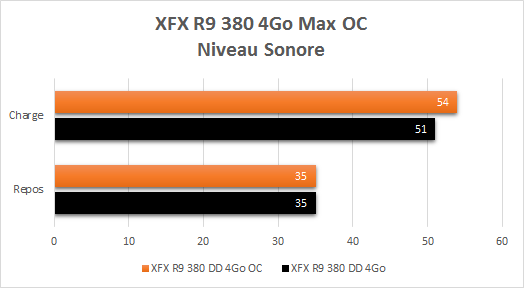
Indeed we go from a maximum of 51 dB of origin (which is already very high and not really pleasant to use if the configuration is close, and that we do not use headphones) to 54 dB ! Suffice to say that with this it is clearly better to be far enough from the PC or not to worry about the noise it can generate with the fans of the graphics card at almost 3000 RPM.
Powertune
What will our little Powertune say with the overclocking of the XFX R9 380 4Go? Let’s see right away:

The frequencies could not be more stable even under OCCT with this overclock, the GPU did not drop below 1150 MHz for a single moment during the entire test, a very good thing.
Results
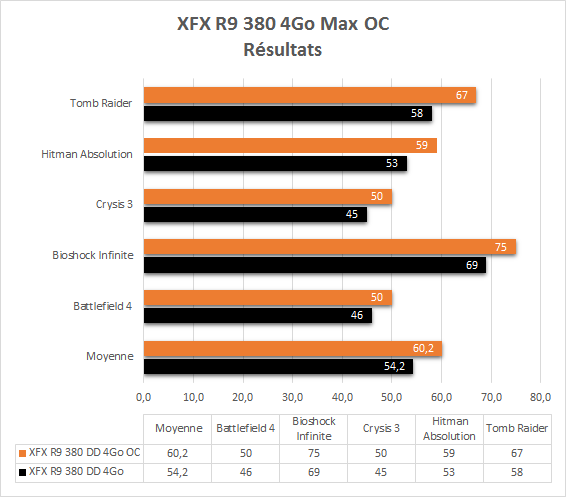
Thanks to this rather nice overclocking we arrive at an average gain of about 11% in games, which is very clearly good to take!
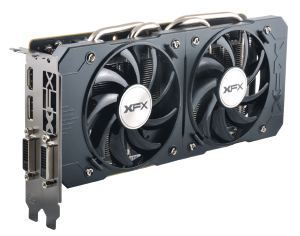
Here we are at the end of this test, what about the XFX R9 380 4Go?
The “new” R9 380 from AMD does in fact largely take over the old R9 285 (almost a carbon copy as you have seen on the PCB) and ultimately offers quite similar performance, my opinion will therefore not change especially compared to what I could say about the R9 285 a year ago! The performance is very good for those who want to play in Full HD, the presence of 4GB on the test card can be useful for some games (even if for a card of this size 2GB will be sufficient in 90% of cases), consumption is under control and the card is compact.
On the other hand the weak point as on the XFX R9 285 is the cooling system, indeed even if it is quite discreet at rest it could be completely silent (since manually it is possible to lower it lower than the 1380 RPM in automatic mode) on load on the other hand this is clearly not good, the fans run at 2700 RPM (without overclocking) and are therefore clearly noisy, too bad because the temperatures are very good and a less aggressive ventilation curve could have saved the furniture.
Offered at a price of around 225 € in its 4GB version (199 € for the 2GB), however, it offers a very interesting performance / price ratio for those looking for a graphics card capable of running games in Full HD in very good conditions. conditions as long as we ignore the noise generated, maybe the future card of your gamer config?
Advantages
- Performance / price ratio
- Quite compact
- Overclocking
- Easy radiator cleaning
A big thank you to Jérémie and Jean-Manuel from Goldenfish who allowed me to do this test.














